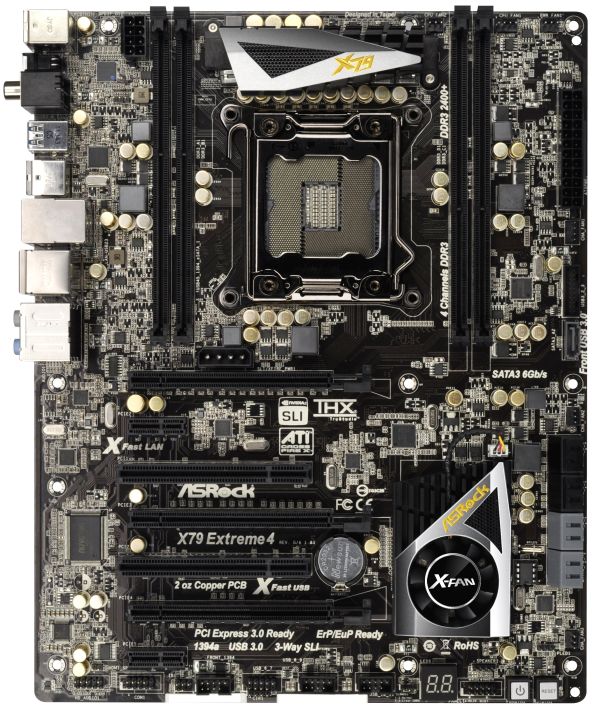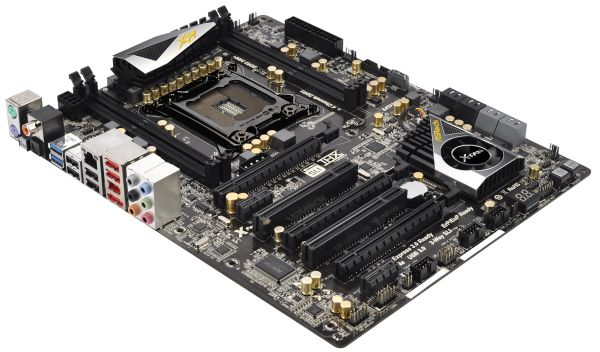ASRock X79 Extreme4-M and X79 Extreme4 Review – Sandy Bridge-E meets mATX
by Ian Cutress on December 9, 2011 12:00 PM EST- Posted in
- Motherboards
- ASRock
- X79
Overview
One of the first things people notice about the X79 Extreme4 is the price – a full size ATX board with the X79 chipset for ~$235 MSRP. As I mentioned in the X79 Extreme4-M overview, there will be demand for such cheap motherboards when more mainstream enthusiasts (rather than pure enthusiasts) may consider spending some, but not a lot, of money on a Sandy Bridge-E system.
With the ATX size, we can take full advantage of all the X79 features. In comparison to the X79 Extreme4-M, there is no lack of space for 40 PCIe lanes between the PCIe slots, there are more SATA 6 Gbps ports, the package has more to it (SATA cables, SLI connectors), and the board is tri-GPU possible. Some users may not like the fact that it has four memory slots (one per channel), but that is part of the reason why the board is cheaper than others. I will touch on this in the conclusion at the end of the review.
Performance on the whole was not too dissimilar to the X79 Extreme4-M, as expected. There were certain tests that this board would be slightly better on, and vice versa, but nothing outside the realms of statistical variance. Like the 4-M, despite the Realtek ALC898 audio, DPC Latency was a bit lacking compared to other X79 boards tested so far since release, probably due to BIOS configurations and maturity. The XFast LAN results however, as with Sandy Bridge P67/Z68 iterations, were a cut above the rest.
Visual Inspection
Perhaps it is just me, but I am starting to like the new ASRock styling. The black and gold angular PCH/heatsink style works quite well in my view of a top of the range motherboard, even if this is the more financially realistic end of X79 for the majority of users.
Despite the ability of having eight memory slots on X79, ASRock have decided to reduce the board price by only using one DIMM per channel, meaning four memory slots in total, here with quick release connectors. Given the abundance and low price of 4 GB DDR3 modules recently, and few power users requiring more than 16 GB of memory, using 4 DIMM slots is a good representation to save a few dollars on an overall system build perhaps. We will not be seeing all four memory slots on one side though, due to the pin layout of SB-E. As a result, the power solution to X79 boards are going to be squashed in the area above the socket itself – we see here ASRock have a heatsink covering the 6+2 phase VRM and chokes. A few vendors have this heatsink connected to a heatpipe and another heatsink below the socket, but again ASRock have left this out to save a few pennies.
Fan headers are in abundance, with a total of six. Two CPU headers and a PWR header on the top right, and a chassis header is underneath the 24-pin ATX power connector. Another chassis header is above the main block of SATA ports (which gets completely obstructed by any full length GPU in the first PCIe slot, and a third chassis header below the SATA ports (again, obstructed when a third full length GPU is in use).
Beneath the 24-pin ATX power connector is a USB 3.0 header, and a SATA 6 Gbps port, both provided by ASMedia controllers. The main block of SATA ports contains the typical ports from the Platform Controller Hub (four SATA 3Gbps in black, two SATA 6Gbps in gray), and another two SATA 6 Gbps provided via a controller. Next to this is the PCH itself covered in a black, gold and silver heatsink. As the heatsink is relatively small, ASRock have included a small fan connected to a small onboard header. This fan isn’t set to come on (by default) until the PCH reaches 50 degrees Celsius.
Despite this being one of the cheaper X79 options, we still get power/reset buttons, along with a two-digit debug LED useful for recognizing board issues. Aside from the usual array of headers on the bottom of the board, people will note the colorful use of gold capacitors on the board to tie in with the black/gold theme. ASRock argue in their marketing that these are premium conductive polymer caps – I hope they’re in some way premium, with this being X79.
In terms of PCIe layout, we have good and negative points. At the top is a 4-pin molex connector designed to give the PCIe extra power. For all intents and purposes, I found this largely useless, as two GTX580 GPUs ran quite happily without issue, as they already have their own power connectors and the PCIe specification should provide more power through the slot. It is also in an awkward place, for cable management inside a case. Nevertheless, we cannot really poke holes in the PCIe layout – at the top is a PCIe x16, x1, PCI, x16, PCI, x8, x1. I am thankful for the triple slot gap between the first two GPU x16 slots, and there is some space for any PCIe x1 card at the bottom. This is slightly different to what we normally see when PCIe lanes are at a premium – normally the x1 is at the top.
The back panel layout is identical to the X79 Extreme4-M. To quote, ‘From left to right, we see two PS/2 connectors, a clear CMOS button, a coaxial SPDIF out, an optical SPDIF out, two USB 3.0 ports, six USB 2.0 ports, gigabit Ethernet (Broadcom BCM57781), eSATA 6 Gbps, FireWire, and audio headers. For a board this price and on X79, we do not see much extra from what we would expect to be the standard.’












54 Comments
View All Comments
prophet001 - Friday, December 9, 2011 - link
b/c this is perfect grammar"Also, whats with fascination with older video "
mischlep - Friday, December 9, 2011 - link
Minor typo on recommendations page:(e.g. currently $219 at time of writing, saving £6) Should be "saving $6".
zanon - Friday, December 9, 2011 - link
Interesting review overall. A few comments:Page 6:
You still refer to setup stuff as "BIOS" even though it's clearly (I hope?) UEFI nowadays. Any particular reason for this? Or is it actually still BIOS for real despite clearly saying UEFI on that screen. It's confusing that you use both if you only mean one.
Also on page 6: "With the XFast RAM software, users can shift certain parts of the OS to the RAMdisk, such as the memory pagefile"
What. The entire *point* of a pagefile is that all your physical memory is used up and you're now hitting secondary storage. Reducing your main memory in order to make a RAMdisk that you then...use for memory? Nope nope nope.
Spivonious - Friday, December 9, 2011 - link
Yeah, I don't understand why you'd want the pagefile in RAM instead of just using the RAM.JonnyDough - Friday, December 9, 2011 - link
What he said. Some programs require a pagefile. Allocated memory and a pagefile are not the same.JonnyDough - Friday, December 9, 2011 - link
Also, a pagefile can be dumped/saved on shut down. RAM is cleared.Aisalem - Friday, December 9, 2011 - link
Some of the software will not work properly or will simply crash in some situation if you will have no pagefile enabled. That's why having RAMdisk is very good idea as even if you will have 32GB RAM you still need at least 300MB pagefile on the system to be sure that all software will run proper. Using XFast RAM you simply "cheating" system by creating special partition with only pagefile on it making sure that system is running stable.zanon - Friday, December 9, 2011 - link
Um, no. Windows doesn't have that crappy a VM system, nor does any other modern OS. While some applications may check for the presence of a pagefile if the authors that wrote them were brain dead morons (you should search for other applications in that case), the OS isn't going to start paging anything out of main memory while there is still free or inactive memory available. It'll only start hitting the VM when main memory is consumed. Leave it to the OS. If you want things to go faster once you exceed your maximum physical main memory, get an SSD. Get an SSD anyway, actually.Wardrop - Friday, December 9, 2011 - link
Actually, at work I regularly used up all 8GB of my RAM while running VM's and multi-tasking. When that happened, some programs would spontaneously crash and disappear. Re-enabling the page file (only a small 512MB page file) fixed the problem. This was on Windows 7 x64 by the way. I use to always turn off my page file, but now I always keep a small page file enabled for that reason.JonnyDough - Friday, December 9, 2011 - link
You and Spivonious are so obviously not researched on the matter of using a ramdisk. I suggest you study up before posting, you look like a fool.